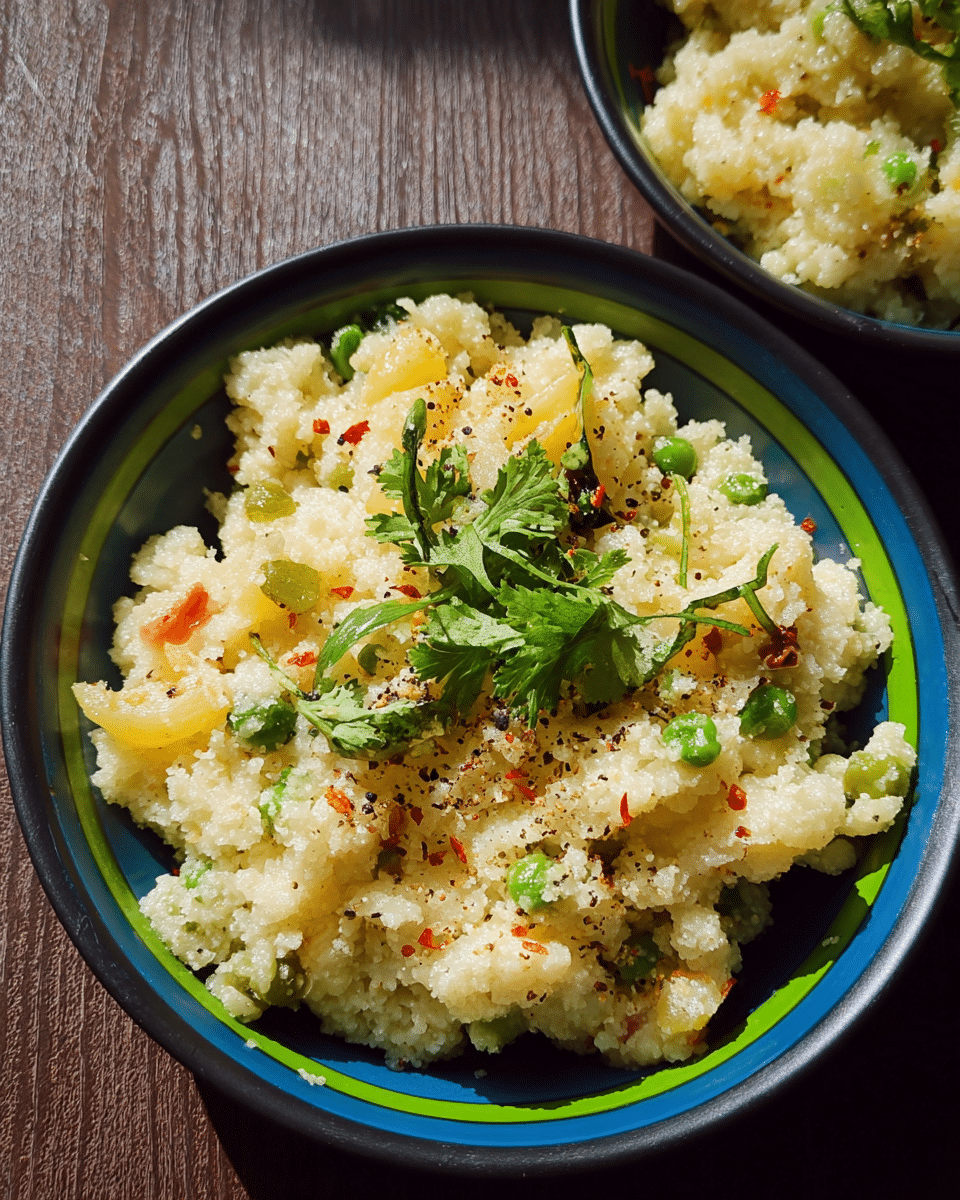The Essence of Upma
At the heart of this beloved dish is rava, a finely ground wheat product that forms the base of the upma. The rava is roasted and then cooked in hot, flavored water, making it absorb the spices, nuts, and other ingredients added to it. This method of preparation creates a dish that is both soft and flavorful, with a slight crunch from the cashews and lentils.
The seasoning in upma plays an important role in elevating the dish. Mustard seeds, cumin, curry leaves, and green chilies offer a fragrant and spicy base, while cashews and lentils provide additional texture and taste. The combination of these ingredients results in a dish that is neither too heavy nor too light, making it a perfect meal to start your day with.
The Versatility of Upma
While the traditional upma is a simple savory dish, there are countless variations to explore. Some might add vegetables like carrots, peas, and potatoes to the dish for added flavor and nutrition. In fact, the vegetable upma is quite popular, and it can be customized according to whatever vegetables you have available. The beauty of this dish lies in how it allows you to be creative with the ingredients while still maintaining the core essence of its flavor.
Upma can also be prepared with different kinds of flours. While semolina is the base for the classic version, you can make ragi upma (using ragi flour) or even use a combination of rice and semolina for a unique twist. In some regions, upma is made with vermicelli or bread, and it is often paired with a sweet dish like kesari or fruit chutney, which balances the savory notes of the upma.
The Nutritional Benefits of Upma
Not only does upma taste delicious, but it also offers various health benefits. Made primarily from semolina, upma provides a good amount of carbohydrates, which gives you the energy needed to kickstart your day. It’s also rich in fiber, especially if you include vegetables like peas and carrots, which help support digestion. Additionally, upma contains healthy fats when cooked with ghee or oil, which aid in the absorption of fat-soluble vitamins.
Furthermore, upma is a great source of protein, especially when you add lentils like urad dal and chana dal. These dals not only enhance the taste but also contribute to the protein content, making the dish more balanced and satisfying. You can also modify the recipe to fit different dietary preferences. For example, you can make it vegan by using oil instead of ghee, or make it gluten-free by choosing alternatives like rice rava or cornmeal.
Upma as Part of South Indian Cuisine
In South India, upma is a staple breakfast item, often enjoyed in hotels or at home. It’s an integral part of the South Indian breakfast spread and can be served alongside idli, dosa, or vada. Upma is a versatile dish that can also be eaten as a snack or light dinner. Its ability to be customized to various regional preferences makes it a popular choice in different parts of India.
For example, in Karnataka, upma is sometimes served with a sweet dish called kesari, forming the popular chow chow bath combo. In Tamil Nadu, it’s often served with a tangy lemon pickle, which complements the savory nature of the upma. In Kerala, upma is frequently paired with coconut chutney, making it a perfect breakfast for any time of the day.
Tips and Tricks for the Perfect Upma
Making the perfect upma might sound simple, but there are a few tricks to ensure that it turns out soft, non-lumpy, and flavorful. One of the most important steps in making upma is roasting the semolina (rava). Roasting the rava on low heat ensures that it becomes fragrant and doesn’t get soggy. You should roast it until it turns slightly golden, but avoid over-browning it, as this could alter the taste and texture of the upma.
Another important tip is to add the rava in batches when mixing it with hot water. Adding it in stages prevents the upma from becoming lumpy, resulting in a smooth and fluffy texture. Always make sure that the water is hot and that the rava is mixed in thoroughly with the water as it cooks.
Upma Variations
While the classic upma is delicious on its own, you can explore several variations to keep things exciting. For instance, a vegetable upma incorporates a variety of finely chopped vegetables like carrots, peas, and beans, adding color and nutrition to the dish. If you like a bit of tanginess, you can add a bit of lemon juice or serve it with a side of pickles.
Another variation is the tomato upma, where tomatoes are sautéed with the spices before adding the rava, giving the dish a tangy and rich flavor. You can also experiment with the addition of different spices and herbs to give it a unique twist. For instance, adding a pinch of garam masala or a few curry leaves can lend a distinct taste that elevates the dish further.
Serving Suggestions
Upma is best served piping hot or warm. Pairing it with coconut chutney or a drizzle of lemon pickle enhances the flavor profile and balances the savory nature of the dish. In some regions, upma is garnished with sev or fried gram flour noodles, providing an additional crunch. For an extra indulgence, you can drizzle a bit of ghee over the upma before serving, which adds richness to the dish.
You can also serve upma alongside a cup of masala chai or filter coffee, which are traditional Indian beverages that complement the spiciness of the upma. If you prefer a lighter beverage, opt for fresh coconut water or a simple glass of buttermilk.
Conclusion
Upma is more than just a breakfast dish; it’s a comfort food that brings warmth and nourishment. Its simplicity, combined with the depth of flavor from spices and herbs, makes it an enduring favorite. Whether you’re new to South Indian cuisine or looking for a dish to add to your regular breakfast rotation, upma is a versatile and satisfying option that can be enjoyed in countless ways. By experimenting with different ingredients, flavors, and toppings, you can customize this dish to suit your tastes and preferences. So why not give this delightful South Indian breakfast a try? You’ll surely fall in love with it!






